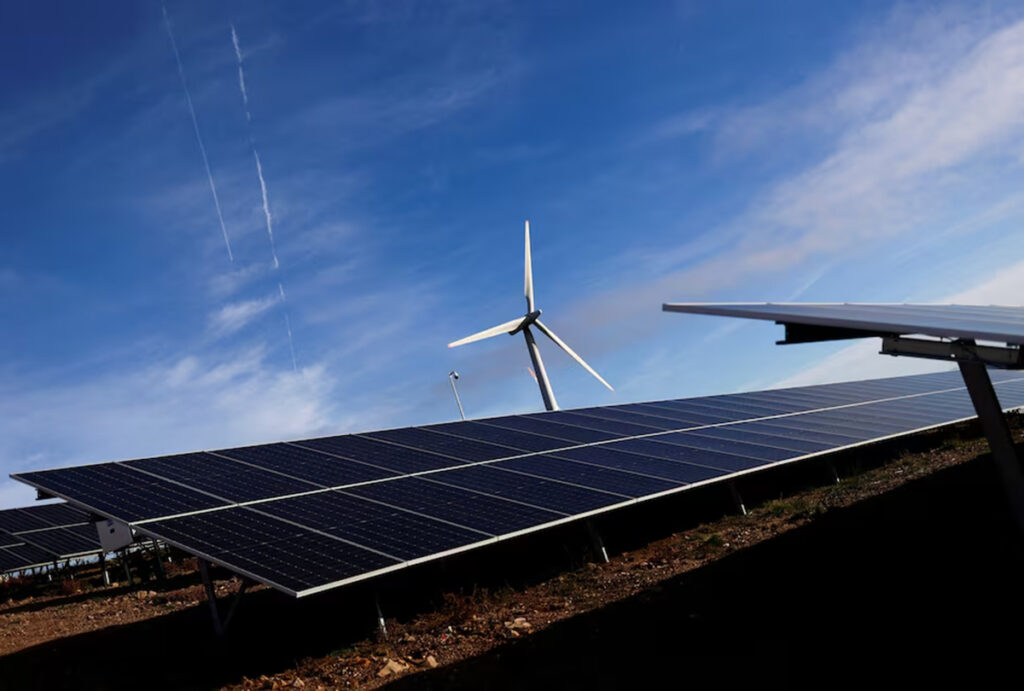
View of a hybrid power park with solar panels and wind turbines in Sabugal, Portugal, January 12, 2023. REUTERS/Pedro Nunes/File Photo
LITTLETON, Colorado, April 8 (Reuters) – The energy transition away from fossil fuels towards cleaner sources of power and electricity is advancing on every continent, but at an uneven pace due to widely different levels of investment, policy support and societal backing.
Countries across the world have been steadily boosting clean electricity supplies for more than a decade, mindful of the multiple benefits of decarbonising power systems.
The pace of clean power adoption has accelerated in the past five years, especially in Asia, Europe and North America where a mix of factors including a rush to cut reliance on fuel imports and a drive to create jobs and expertise in a fast-growing sector have jolted governments and businesses into action.
But the routes towards cleaner electricity supplies vary greatly even within the same continents, as is the case in Europe: France secures two-thirds of its power from nuclear reactors, Norway gets around 90% from hydro dams, and Denmark gets nearly 70% from wind and solar farms.
The wide span of available clean power solutions demonstrates there is no fixed path towards decarbonising power systems, but rather a suite of tools that can be optimised according to each country’s unique mix of geography, geology, legacy energy systems and space constraints.
Below is a summary of where key countries in major regions stand in terms of how much electricity comes from clean sources.
REGIONAL REVIEW
As of the end of 2023, Latin America and the Caribbean had the largest share of electricity produced from clean sources (69.3%) of all regions, data from energy think tank Ember shows.
Europe came second with around 59% of electricity produced from clean sources, followed by Oceania with around 49%, and North America with around 47%. Asia had around 30% of its electricity produced by clean sources as of late 2023.
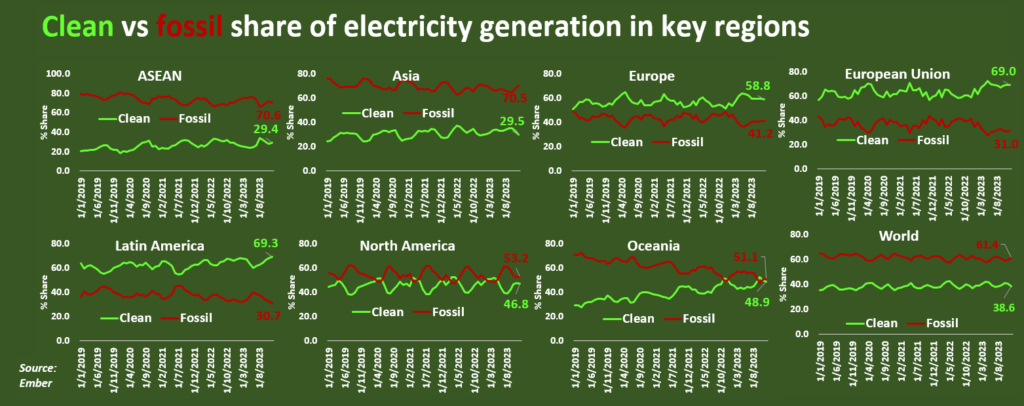
Clean vs fossil share of electricity generation in key regions
Ember does not track Africa and the Middle East regions on a monthly basis, but the latest annual generation statistics suggest they currently secure around 25% and 5%-6% respectively from clean sources.
EUROPEAN MOMENTUM
Europe has been one of the most active regions for clean energy development in recent years following Russia’s invasion of Ukraine which roiled power markets across the continent and sparked a scramble to reduce regional reliance on fuel imports.
A majority of large European economies sourced more than half of their total electricity supplies from clean sources as of the end of 2023.
Some European countries such as France, Finland, Sweden and Norway have secured a majority of their electricity from clean sources for several years, thanks to well-established nuclear reactor fleets or extensive hydro dam networks.
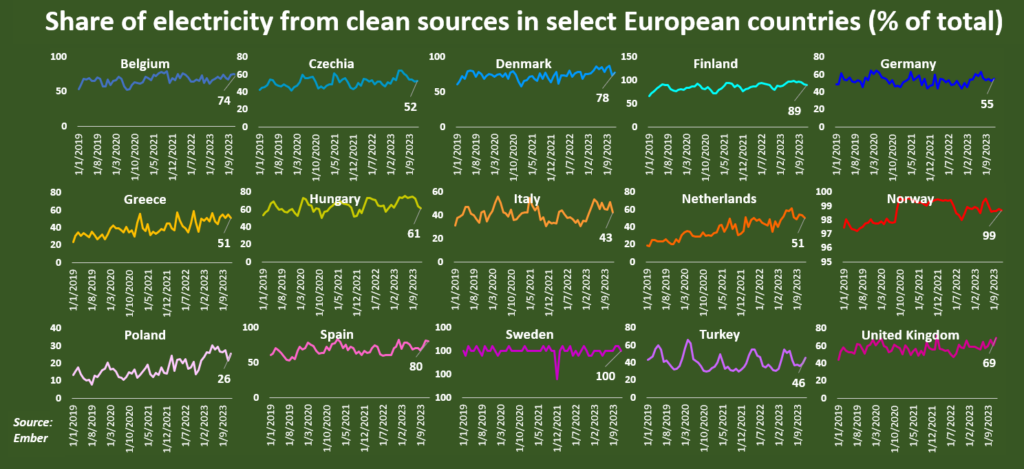
Share of electricity from clean sources in select European countries (% of total)
Others have been more recent adopters of clean electricity generation sources, such as the Netherlands and Poland which have both doubled clean energy’s share of total electricity generation within the past five years.
Aggressive region-wide plans for additional development of solar and wind production capacity look set to keep Europe at the forefront of fast-developing clean energy markets going forward.
MIXED BAG IN THE AMERICAS
Countries across the Americas have a wide span of clean electricity generation levels.
In Latin America, long-time clean energy giant Brazil has secured over 75% of its electricity from clean sources – mainly hydro dams – for decades.
Similarly, Colombia, Venezuela, Uruguay and Paraguay all get 70% or more of their electricity from clean sources thanks to hefty hydro networks.
Chile (77% clean as of late 2023) relies on a mix of hydro, solar and wind for its clean electricity supplies.
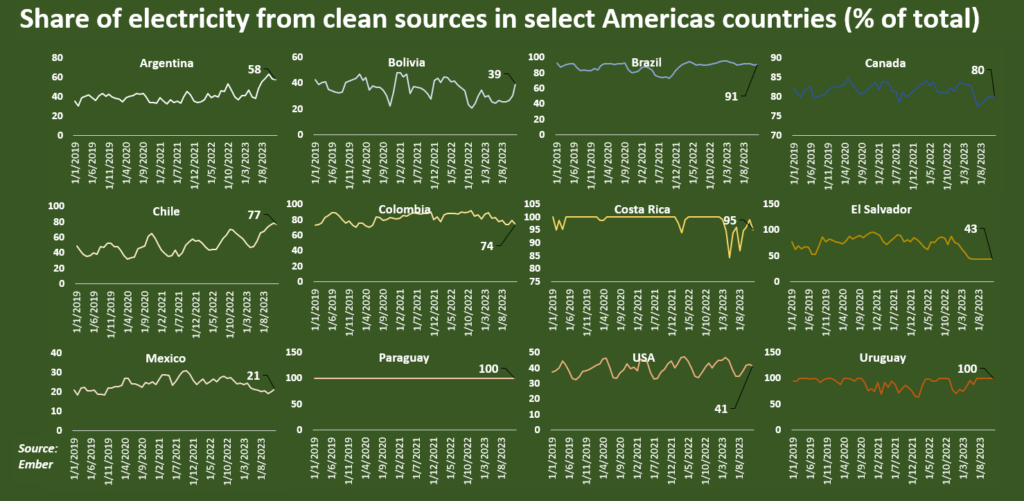
Share of electricity from clean sources in select Americas countries (% of total)
Farther north, the share of clean energy in electricity generation mixes tends to fall.
Mexico has one of the lowest clean shares in the region (21% as of late 2023) while the United States (41%) and El Salvador (43%) also have clean shares of less than 50%.
Canada sources around 80% of its electricity from clean sources, thanks again to an extensive hydro network.
ASIAN GROWTH DRIVERS
Asia is home to some of the fastest-growing and largest clean energy generation markets, and also some of the most significant laggards.
China’s 31% share of electricity from clean sources is overshadowed by other countries. But in terms of absolute generation heft, China stands alone and produces roughly twice the amount of clean electricity as the next largest producer, the United States.
Coal remains the primary power source for China’s utilities, but record-fast growth in wind and solar capacity means clean power’s share of total generation is rapidly rising.
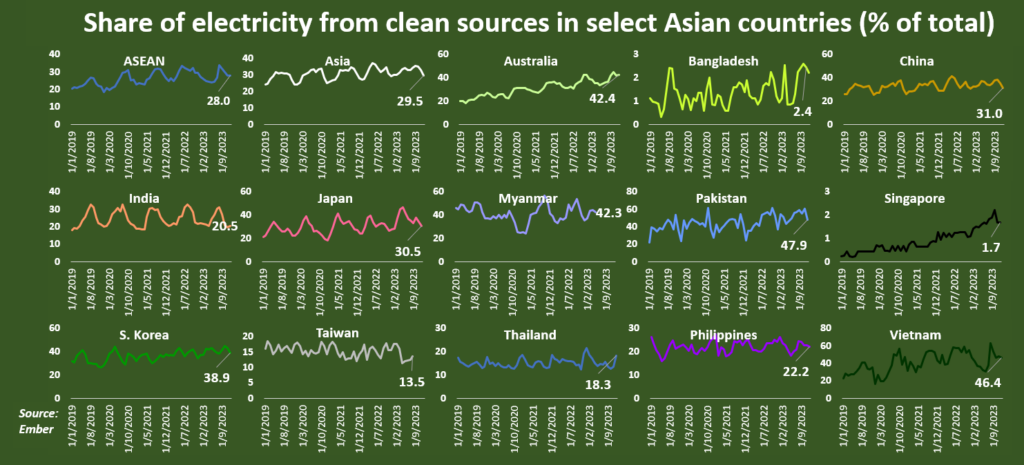
Share of electricity from clean sources in select Asian countries (% of total)
India is also an aggressive clean power deployer, but as of late 2023 secured only around 20%-25% of total electricity from clean sources.
Other fast-growing economies including The Philippines, Thailand and Bangladesh also have relatively low clean power shares, (less than 25%) although Vietnam and Pakistan have clean shares in the high 40% range.
AFRICA & MIDDLE EAST
Patchy power data reporting systems make it difficult to track the clean power progress in all countries, especially in Africa and the Middle East.
With the exception of Kenya and Ethiopia, which boast large geothermal and hydro power generation networks, these regions are clear laggards in terms of clean power momentum.
Heavy enduring reliance on locally-sourced fossil fuels and/or a lack of the funds needed to undertake the energy system overhauls seen elsewhere are major hurdles for clean power development in these regions.
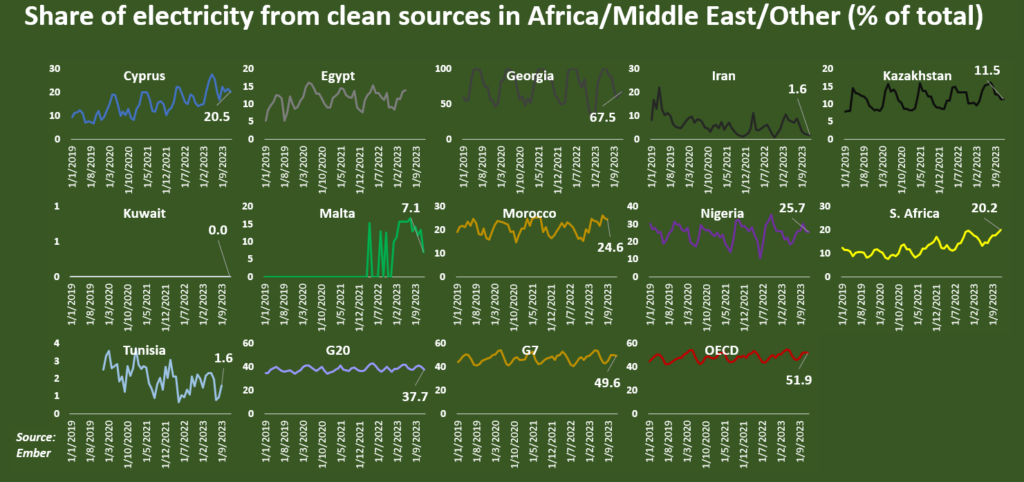
Share of electricity from clean sources in Africa/Middle East/Other (% of total)
In any event, important progress is still evident in several key countries, including Egypt, Nigeria, South Africa, Morocco, and the United Arab Emirates, which should help spur further region-wide progress towards clean generation goals in the decades ahead.
<The opinions expressed here are those of the author, a columnist for Reuters.>
Share This:
Next Article




